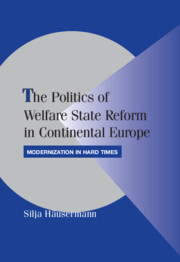Book contents
- Frontmatter
- Contents
- List of Figures
- List of Tables
- Preface
- The Politics of Welfare State Reform in Continental Europe
- 1 “EPPUR SI MUOVE”: WELFARE STATE CHANGE DESPITE INSTITUTIONAL INERTIA
- 2 MODERNIZATION IN HARD TIMES: THE POST-INDUSTRIAL POLITICS OF CONTINENTAL WELFARE STATE REFORM
- Part I Pension Reform in Continental Europe: A Framework of Analysis
- Part II Determinants of Successful Pension Reform in Continental Europe
- Appendices
- References
- Index
- Cambridge Studies in Comparative Politics
Appendices
Published online by Cambridge University Press: 06 July 2010
- Frontmatter
- Contents
- List of Figures
- List of Tables
- Preface
- The Politics of Welfare State Reform in Continental Europe
- 1 “EPPUR SI MUOVE”: WELFARE STATE CHANGE DESPITE INSTITUTIONAL INERTIA
- 2 MODERNIZATION IN HARD TIMES: THE POST-INDUSTRIAL POLITICS OF CONTINENTAL WELFARE STATE REFORM
- Part I Pension Reform in Continental Europe: A Framework of Analysis
- Part II Determinants of Successful Pension Reform in Continental Europe
- Appendices
- References
- Index
- Cambridge Studies in Comparative Politics
Summary
This appendix presents the methodological approach of this book, including the selection of the reforms and actors included, the coding procedure, sources, and methods of analysis.
Selection of Reforms and Actors Included in the Analysis
The study includes all thirty-six pension reforms that took place in Germany, France, and Switzerland between 1970 and 2005. Tables A1.1–A1.3 provide an overview and the references to the official documentation (call number).
The choice of actors is an important issue. If the goal is to understand policy dynamics, it is best to include all actors who actually participated in the reforms and who have a say in the specific country. The analyses in this book include all political parties that made a statement on the reform in the plenary parliamentary debates (France, Germany) or in the official consultation procedure that preceded parliamentary debates (Switzerland). A similar approach guided the selection of trade unions and employer organizations for the cases of Germany and Switzerland. The major peak trade unions and employer organizations participate in all reforms, which is why they are included in all the analyses. In addition, sectoral trade unions and employer organizations were included, if they delivered their own separate statements in the consultation procedures, because the separate statements are indications of intralabor or intracapital conflict. In France, such an inductive approach to the selection of corporatist actors is impossible, as there is no official consultation procedure.
- Type
- Chapter
- Information
- The Politics of Welfare State Reform in Continental EuropeModernization in Hard Times, pp. 219 - 246Publisher: Cambridge University PressPrint publication year: 2010

